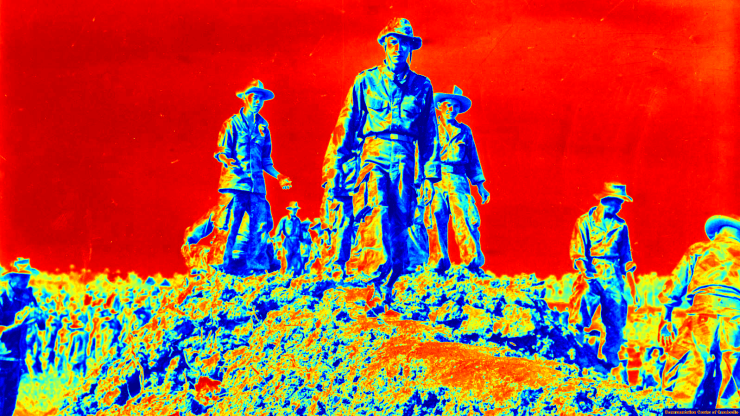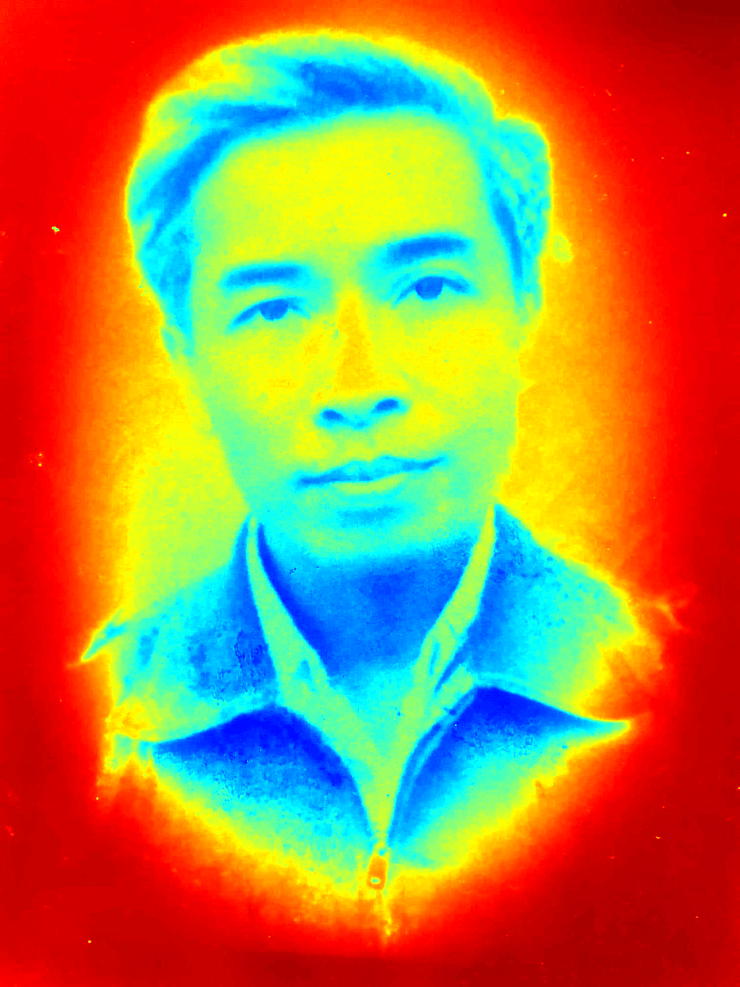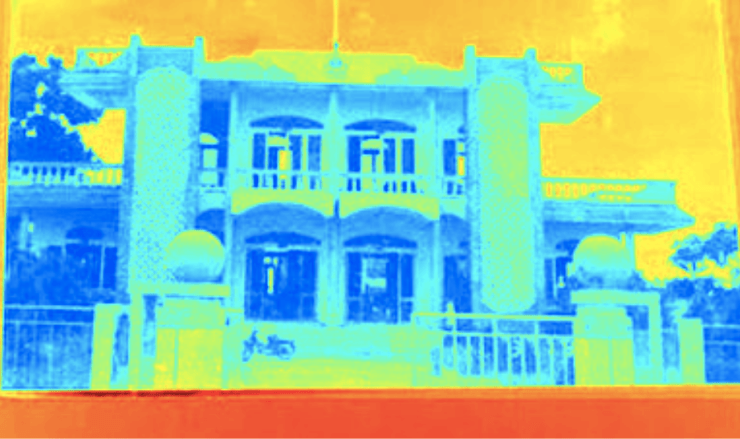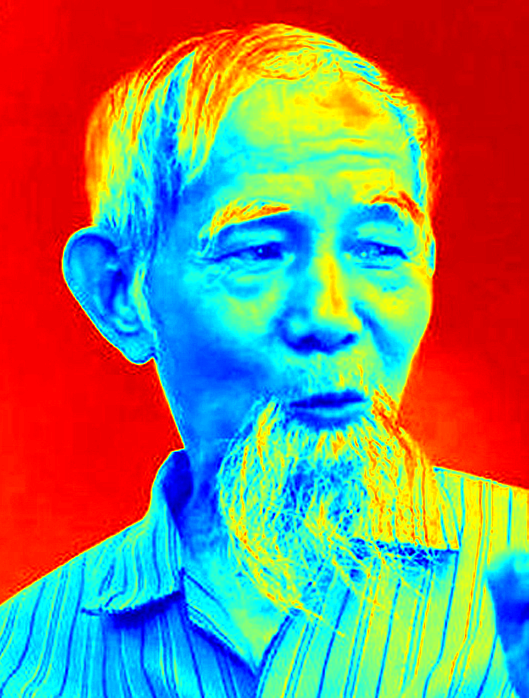In Death, All Debts Are Settled?
Đan Thanh wrote this article in Vietnamese, published in Luat Khoa Magazine on July 9, 2025. Đàm Vĩnh Hằng translated

A 100 years have passed in Vietnam, but the people continue to shed their blood over the ownership of their land.
We all wish to live in peace and harmony. But try to imagine, just for once, if we were put into the shoes of the people whose lands are taken away by others, what would we do?
Whether being ruled by the French during colonization or under the dictatorship of the Vietnam Communist Party, the people who lost their land all faced the same despairing fate. One step forward and they could become criminals facing jail sentences or even the death penalty. One step backward and they could lose everything.
Throughout this 100 years, Vietnamese people have gone from Noc Nan Field to Senh Field, from Ninh Thanh Loi Village to Lac Nhue Village, from the Tay Nguyen Uprising to the Thai Binh Uprising, from Dak Nong Province to Hai Phong Province, and still there is no end in sight for the land ownership disputes.
We will take a look at 10 notorious cases of land disputes in Vietnam over the past 100 years.

Time of dispute: January to May, 1927
Area of dispute: around 300 acres
Victim: Boss Chot
Offender: A local chief (cai tổng) named Tr.
Fatalities: 24
Location: Ninh Thanh Loi Village, Phuoc Long District, Rach Gia Province (now located in Bac Lieu Province)
Time after time, local officers seized 90 percent of the agricultural land of this Khmer village. They learned all about the law on land confiscation and also the tricks to get around them.
At that time, a local chief named “Tr.” ordered the village chief to prepare land confiscation papers. They planned to confiscate a 300-acre plot of land that belonged to a Khmer local boss who was of Chinese origin named Chot. Boss Chot was not an easy target. He sued the village chief and won the case. To protect his land against the local officials, Boss Chot initiated a plan.
In May 1927, a French field supervisor broke up a traditional ritual set up by Chot to boost his men’s spirit. Chot then captured four farmers on the land of the supervisor and took them home. Next, he set up lines of white thread surrounding his land and prohibited any trespassing.
On May 7, 1927, the chief of Phuoc Long District set up an ambush on Chot’s group but neither side suffered any damage. That night, Chot’s men came to the house of local chief Tr. to take revenge but did not find him. They killed his father instead.
The next fight broke out following an order from the chief of Rach Gia Province, which resulted in six deaths on Chot’s side and three deaths on the side of the authorities. During the final encounter, the vice chief of Can Tho Province sent men to back up Rach Gia. And this time, Chot’s men were completely outnumbered. He, His daughter, and 12 other people were killed right at the scene.
After the incident, the chief of Phuoc Long District and officers of Ninh Thanh Loi Village reported to their superiors that it was an uprising against the state, instead of a land dispute. The French governor disagreed with the claim. He believed Chot’s initial purpose was to fight against the local corrupt officials who robbed his land, and that with just 40 men Chot could not create an uprising against the state. Instead, it must have been a normal land dispute. The French governor recommended that the governor-general of Indochina review the land law for the Khmer people, and pledged to solve land dispute cases in Ninh Thanh Loi Village in a fair manner.

Time of dispute: 1919-1928
Area of dispute: 72.95 acres
Victims: The families of Bien Toai and Muoi Chuc
Offenders: Mother-in-law of a brother of the chief of Gia Rai District
Fatalities: 5
Location: Ninh Thanh Loi Village, Phuoc Long District, Rach Gia Province (now in Bac Lieu province)
A year after the Ninh Thanh Loi Incident, southern Vietnam was again rocked by the Noc Nan case. Confiscated lands represented the blood and bones of the farmers. When pushed against the wall by injustice, they were ready to sacrifice their own lives to keep the land. The Bien Toai and Muoi Chuc families did exactly just that for their lands.
After the fight that led to the death of four family members of the Bien Toai and Muoi Chuc families, and a French policeman, the case was brought to Can Tho Criminal Court. Two French attorneys voluntarily took the case and defended the two families. Most newspapers in Saigon sent their staff to follow the case live in the courtroom.
Before the deadly face-off, the Bien Toai and Muoi Chuc families had tried all legal means to protest to the authorities but to no avail. They had been working on their agricultural land that was inherited from their grandfather which had a legal leasing paper. Then a Chinese named Ma Ngan secretly plotted with local officers to rob their land.
In 1917, Ma Ngan bought a piece of land next to Bien Toai’s property. He paid extra to the landowner to put into the contract that the purchased area included the Bien Toai family’s land. In 1926, Ma Ngan obtained official legal ownership of the land through bribery. The Bien Toai and Muoi Chuc families now suddenly became farmers working for other people but on the land which they always thought was theirs. Meanwhile, Ma Ngan was aware of his dirty tricks so he did not plan to make a big scene out of it. Instead, he silently sold the land to Ho Thi Tr., the mother-in-law of a brother of the chief of Gia Rai District.
Mrs. Tr. then asked the court for an order to collect all taxes on the land by confiscating all the rice produced by the Bien Toai and Muoi Chuc families. On February 16, 1928, two French policemen accompanied by four soldiers and the village officials carried out the court order on the two families.
At first, Ms. Ut Trong represented the families to monitor the rice calculation process. When the calculation was completed, she asked for an invoice for the rice taken but the group refused and a fight broke out. Members of the Bien Toai and Muoi Chuc families showed up to fight the authoritie’s men. This resulted in the deaths of one French policeman, three younger brothers of the Bien Toai family named Muoi Chuc, Nhan, and Nhin, together with Nghia, the wife of Muoi Chuc.
In court, even the prosecutors defended the farm families. The French prosecutor stated that the Bien Toai and Muoi Chuc families were put in incredibly unjust circumstances. Their land was seized by a conman and their rights were ignored by local officers. It was so cruel because the farmers were ordered not only to hand over all of the rice they produced as a tax, but also had to pay extra money for using their own land.
The two attorneys argued that these genial farmers were victims of a legal system built by the French that was full of loopholes which was abused by men in power.
The court later announced that Bien Toai, his youngest brother, and his son were to be released. Ms. Ut Trong received a six-month sentence, which was the time she had already been held in prison, and so she was also released immediately. Bien Toai’s brother-in-law received a two-year sentence due to his prior record of stealing.
The court ruling was widely celebrated and reported by newspapers all over southern Vietnam.

Time of dispute: 1955-1970
Victims: Indigenous people in Cao Nguyen (Central Highlands) and other areas in southern Vietnam
Offenders: The government of The Republic of Vietnam and migrants
Fatalities: Unknown
Beginning in 1954, the government of President Ngo Dinh Diem carried out an “absolute equality” policy to assimilate all the communities in the Cao Nguyen area. This policy allowed the confiscation of land of the ethnic Thuong people and transfer to Kinh people, the Vietnamese ethnic majority, and banned all traditional customs and rituals in Cao Nguyen. That was a rollback of the previous authority’s policy where the French had granted Cao Nguyen a special autonomy policy. Before, under French rule, the government restricted the migration of ethnic Kinh people to this area, respected the land rights of the locals and prioritized the use of traditional customs to resolve disputes.
After years of peaceful protest without progress, some local people formed a military group called FULRO (United Liberation Front for the Oppressed Races) in 1963. The group represented not only various ethnic peoples in the Central Highlands, but also the Cham and Khmer. They also received support from the Cambodian government.
Below are some noteworthy incidents.
On September 20, 1964, FULRO men opened fire on a military camp in Buon Me Thuot, captured six American soldiers as prisoners and occupied the radio station. The next day, the force captured an American colonel. In September 1965, FULRO attacked a Vietnamese military camp. In December 1965, Pleiku and Phu Bon were attacked by the force, which led to the authorities carrying out death sentences against four FULRO soldiers.
The years-long conflict put ethnic Kinh people under constant panic. FULRO demanded that the Saigon government carry out many policies, including evicting all the ethnic Kinh out of Cao Nguyen and returning the land to the Thuong ethnicity. It took the Saigon government a great amount of time and effort to settle this racial conflict. They had to implement land policies which gave priorities to the Thuong people.

Time of dispute: 1990 – 1993
Area of dispute: 75 acres
Victims: Lac Nhue Village
Offenders: Kim Bang district government
Fatalities: 5
Location: Lac Nhue Village, Dong Hoa Parish, Kim Bang District, Ha Nam Province
After so many futile attempts to make appeals for land disputes and against local official corruption, the Lac Nhue village people decided to take matters into their own hands under the leadership of a person whom they all trusted named Trinh Khai. Details about this dispute were scarcely reported since the government wanted to suppress all related information involving the case.
After many years of teaching at the Marine University, Trinh Khai, an engineer who studied in Soviet Russia, retired to his hometown in the early 1990s. At the time, the local officials in Kim Bang District implemented a new agricultural land leasing system. They cut off 75 acres of land in Lac Nhue Village and granted it to another village. Mr. Khai, who had good knowledge of the laws and also experience with the dirty tricks used by local officials, helped the village farmers to make appeals at the parish level, the district and even all the way up to the central government.
After many incidents in which strangers snuck into the village and threatened Mr. Khai and other people’s safety, the villagers decided to build a fortress to protect them from the outside world.
The peak of the conflict came when two young men from outside of the village were beaten to death by villagers in the middle of the night. The villagers believed the authorities sent the men to assassinate Mr. Khai. State media meanwhile reported that these two men were just normal citizens who came to buy fingerlings.
After this incident, it was reported that Mr. Khai was arrested when he showed up at the parish office to cooperate with the authorities. There was also information stating that the authorities had ordered the police to hunt down and arrest him. In the end, the leader who protected the land rights of the farmers was given a death sentence. According to veteran journalist Pham Thanh, two villagers also died while being held in prison and six others were given jail sentences.
In a nutshell, this incident was no different than the case in Ninh Thanh Loi, except that the current government did not act fairly like the lieutenant governor of Cochinchina in the past. This time, the government did not judge this case in an unbiased manner. Instead, the authorities consistently claimed the Lac Nhue incident was a case of land dispute where people distorted state policies and constituted conspiracies against the state. The government even published novels and made a movie about the incident (titled “The story of Nho Village) to defame Lac Nhue villagers and Mr. Trinh Khai, letting them go down in history in eternal shame.

Time of dispute: 1987 – 1997
Victims: Citizens of Thai Binh Province
Offenders: Officials of Thai Binh Province
Fatalities: Unknown
Location: The entire area of Thai Binh Province
In the 1990s, petitions from citizens of Thai Binh Province regarding land issues and local officials’ widespread corruption piled up yet remained unresolved.
In May 1997, furious after years of being bullied by local officials, a group of army veterans led about 3,000 farmers to stage a sit-in protest in front of the Communist Party’s headquarters in Thai Binh Province. This event led to a series of uprisings demanding justice throughout the province.
Two retired officials told journalist Huu Tho about the root cause of the uprisings: “Do you believe that we are the bad guys or the reactionary force?” he asked. “How could we put up with these officials when they bully us even worse than the feudal landlords?!”
Tens of thousands joined the protests and riots, captured at least 64 officials and policemen as hostages, and vandalised many government buildings and private houses of local officials. The unrest lasted until November 1997. Many people were sentenced to prison for taking part in these protests.

Time of dispute: 2001 – 2004
Victims: Indigenous people in the four provinces of the Central Highlands
Offenders: Authorities, migrants
Fatalities: At least 33
Location: Central Highlands
The Communists learned nothing from the mistakes of the earlier administration of Ngo Dinh Diem. They also understood nothing about the Central Highlands. The government thought this area was still covered with vast uncultivated lands. They then created new economic zones, built vast agricultural farms, and allowed unrestricted migration from other parts of the country. The result was that the land area of the indigenous people was disproportionately scaled back and the native people in the Central Highlands found themselves in unprecedented harsh living conditions.
Researchers Neil L. Jamieson, Le Trong Cuc and A. Terry Rambo in their 1998 report, The Development Crisis in Vietnam’s Mountains, East-West Center predicted a crisis in the making in the Central Highlands:
“A lot of people in the highland areas start to realize they are poor and left behind. They feel inferior to the people from the lowlands, […]. Lack of money, lack of food, lack of access to natural resources, public services (education, healthcare, information), they are in danger of losing their most valuable assets: their confidence and dignity. […] The problem is more and more people are aware that they are poor.”
As if pouring gas on a fire, the Communists also destroyed the most sacred thing in the lives of the ethnic Thuong people: religion. The government completely banned religious freedom in the Central Highlands. Traditional rituals were terminated, Protestantism was almost disallowed, and Catholics were stringently restricted.
A crisis suddenly arose in 2001 and especially in 2004 with the uprising of the ethnic Thuong people. It led to the biggest protests up until then and many violent encounters with the police. The Thuong demanded that the government return their lands and guarantee their freedom of religion. The protests forced thousands of ethnic Thuong either to become refugees in Cambodia or to be sent to education camps and prisons in Vietnam. According to Human Rights Watch, the conflict resulted in eight deaths in the protests and 25 deaths in prisons. However, these figures are impossible to verify since the government prohibited international observers from entering the Central Highlands at the time.

Time of dispute: 2009 – 2012
Area of dispute: 19.3 hectares
Victims: The Doan Van Vuon family
Offenders: People’s Committee of Tien Lang District
Location: Vinh Quang Village, Tien Lang District, Hai Phong City
The situation of the Doan Van Vuon family was exactly what the Bien Toai and Muoi Chuc families had faced about 80 years before, but with a different outcome. Although the local officials’ decisions were completely wrong and there were no fatalities in the conflict, the members of the Doan Van Vuon family still faced jail sentences.
Doan Van Vuon, a military veteran, received a five-year sentence while three family members were given sentences ranging from two to five years in prison and suspended sentences.
On the government side, there was only one local official sentenced to 30 years in prison, with the rest given suspended sentences.
The incident started in 2009, when Tien Lang District reclaimed land that had been given to the Doan Van Vuon family.
In 1993, the local authority handed Vuon’s family 21 hectares and it determined that this decision was legal.
However, in 1997, the local authority handed him another 19.3 hectares and this was later concluded as an illegal decision.
The local authority’s decisions, from the second handing of 19.3 hectares of land to the forced reclaiming of land of the Vuon family, did not have any legal basis. Then Prime Minister Nguyen Tan Dung pointed out that the overlapping and confusing regulations regarding land management and officials’ inability to implement the laws were the root causes of the conflict.

Time of dispute: 2012 – now
Area of dispute: 73 hectares
Victims: A number of families in Cuu Cao Village
Offenders: Government of Van Giang District
Fatalities: 2
Location: Cuu Cao Village, Van Giang District, Hung Yen Province
The citizens of Van Giang took a step forward to protect their land and they became criminals. In these types of conflicts, when the government sided with corporations (in this case it was Ecopark) to shrink compensation for reclaimed land, the people had no other choice but to stand up and fight.
In April 2012, the authorities sent between 2,000 and 4,000 military police to sweep away a group of citizens who vowed to protect their land. There were 20 citizens arrested after this incident.
In August 2013, a number of families captured and tied up village officials for trespassing on their uncompensated lands. The incident resulted in one man receiving a 21-month sentence and one other receiving a two-year sentence.
In October 2014, two security guards of a backfilling company were beaten to death and one excavator truck was burnt. This led to six people receiving three-to-four year sentences, despite their statements that they neither beat anyone nor vandalized any assets.

Time of dispute: 2008 – now
Victims: Dang Van Hien and other families
Offenders: Long Son Co.
Fatalities: 3
Location: Small zone no. 1535, Quang Truc Village, Tuy Duc District, Dak Nong Province
This area witnessed many fiere conflicts. There were many fights between migrants and agricultural companies who were offered the land by local authorities. Fist fights, house burnings, field vandalizing, and gun shootings were all familiar to the local people. They chose to rely on themselves to protect the land rather than counting on the authorities.
Dang Van Hien did not want any trouble, but he had no choice. Since 2008, local authorities had offered Long Son Co. an area that included land belonging to Hien and other families. Many violent encounters broke out over the years between the company and the families, yet all levels of government, from province to state, looked away.
One early morning in October 2016,about 30 people came to Hien’s house in a heavy rain to bulldoze his farm. Hien opened fire that day. Ninh Viet Binh, a neighbor, came to back him up. Ha Van Truong, Hien’s cousin, later was also accused of murder, despite the fact that he only handed Hien the bullet magazines.
The incident resulted in the deaths of three workers of the Long Son Co. In court, Hien was given a death sentence, Binh received a 20-year sentence later reduced to 18-years jail time, while Truong was given a 12-year sentence, later reduced to a 9-year prison sentence.

Time of dispute: 2014 – now
Area of dispute: 28.7 hectares
Victims: A number of families in Dong Tam
Offenders: The authorities of My Duc District and Viettel Corporation
Fatalities: 4
Location: Dong Tam Village, My Duc District, Hanoi
From Dang Van Hien to Doan Van Vuon, from Van Giang District to Dong Tam Village, the message of the Vietnam government could not be clearer: despite their lives being threatened, despite their lands being taken away, the people still have no right to fight back. Any act of defiance that creates damage to the authority’s side will be severely punished, whether the government is right or wrong.
Twenty-nine defendants in the Dong Tam case, including a 77-year old man, were forced to fight back against thousands of police ambushing their village in the middle of the night. Since 2007, there have been many violent incidents in Dong Tam yet the government has been unable to resolve the issue in a fair manner.
The government of Vietnam used to denounce the brutality of French colonial rule. However, nearly 100 years ago under French rule, the trial of the Noc Nan field case was open and the press freely took part, reported and conducted independent investigations. Meanwhile, 100 years later, the trial for the Dong Tam Incident was closed and family members of the defendants were not allowed to even get near the court. Independent press was barred from entering the courtroom, and the attorneys were prohibited from making contacts with the defendants at trial.
***
If there is no fundamental change in the land law in Vietnam to allow the private ownership of land, blood may still be shed over land issues for another 100 years.
This article was written in Vietnamese by An Nam and previously published on Luat Khoa Magazine. The translation is done by Y Chan.
Vietnam's independent news and analyses, right in your inbox.